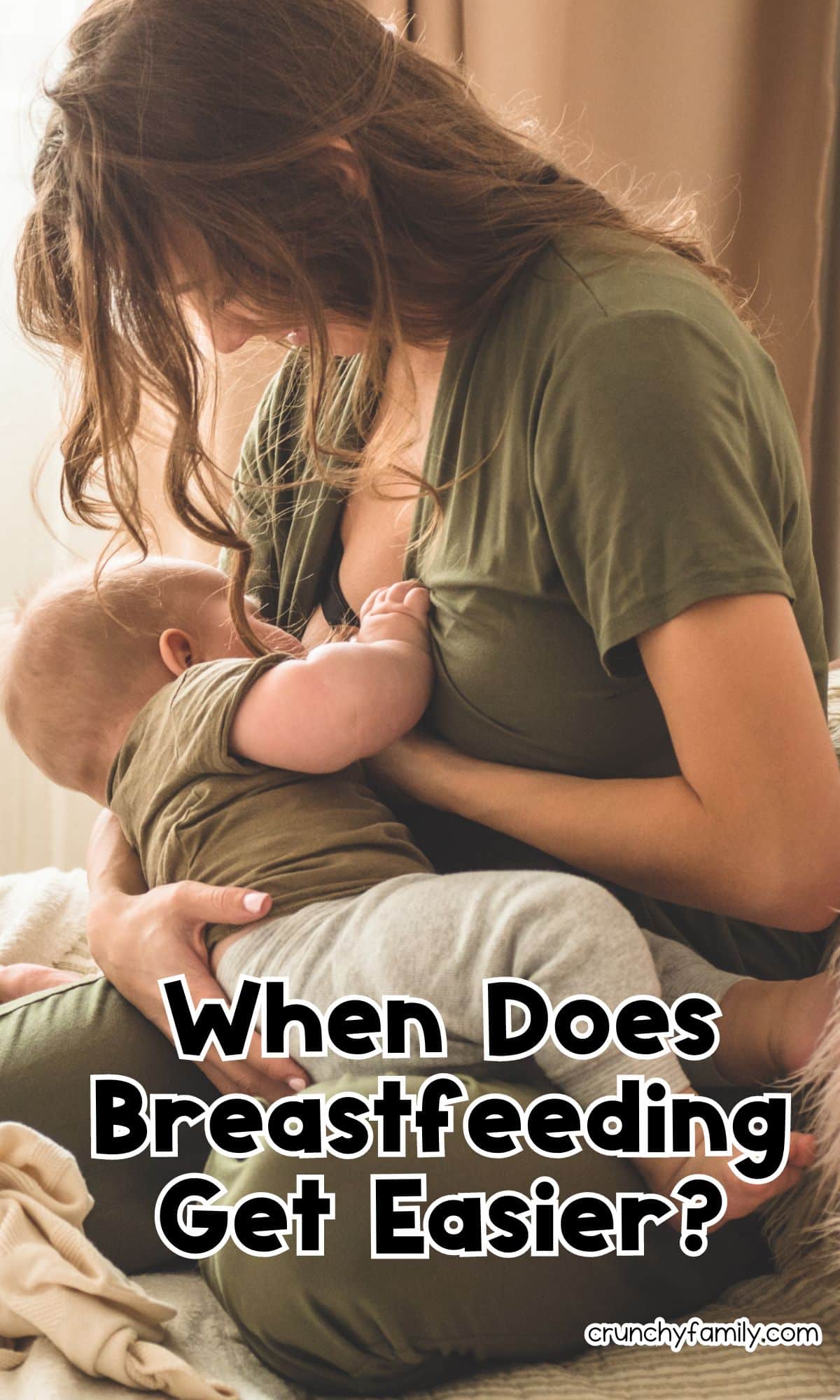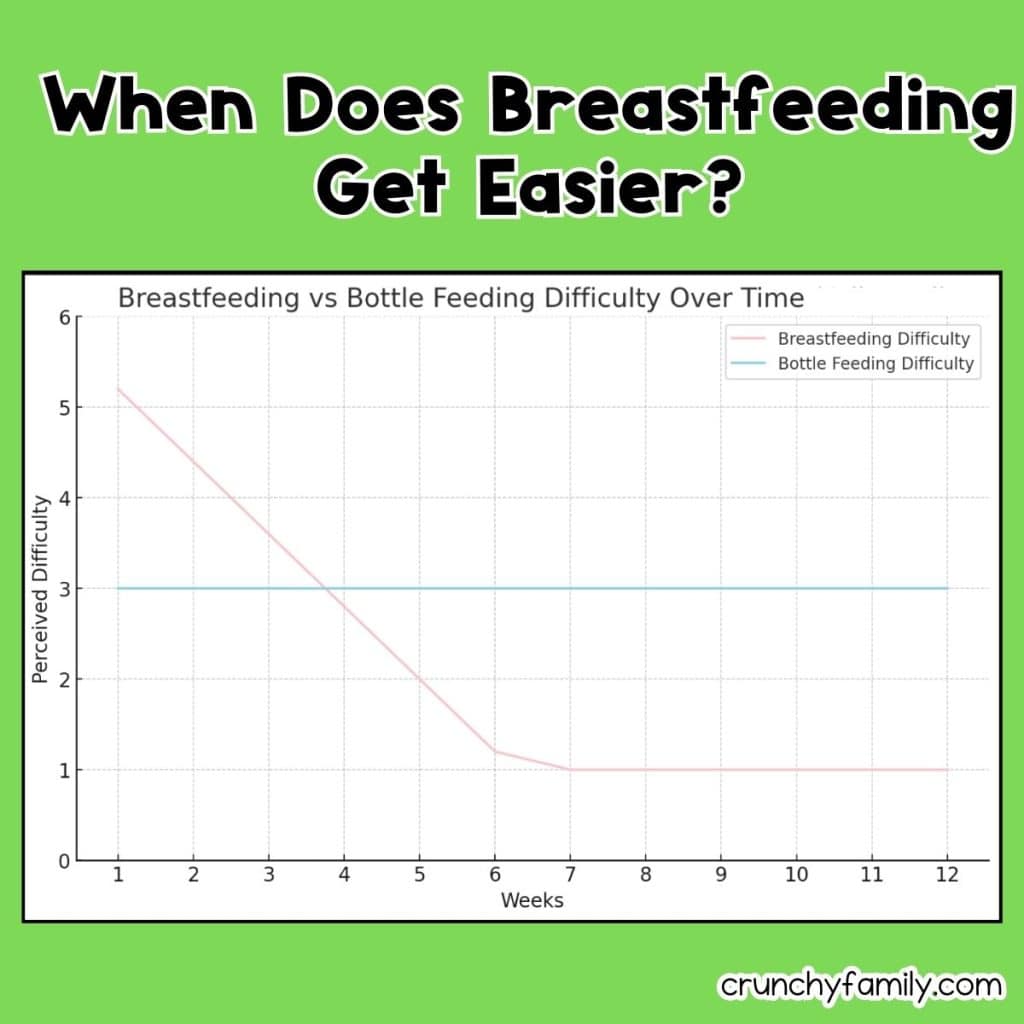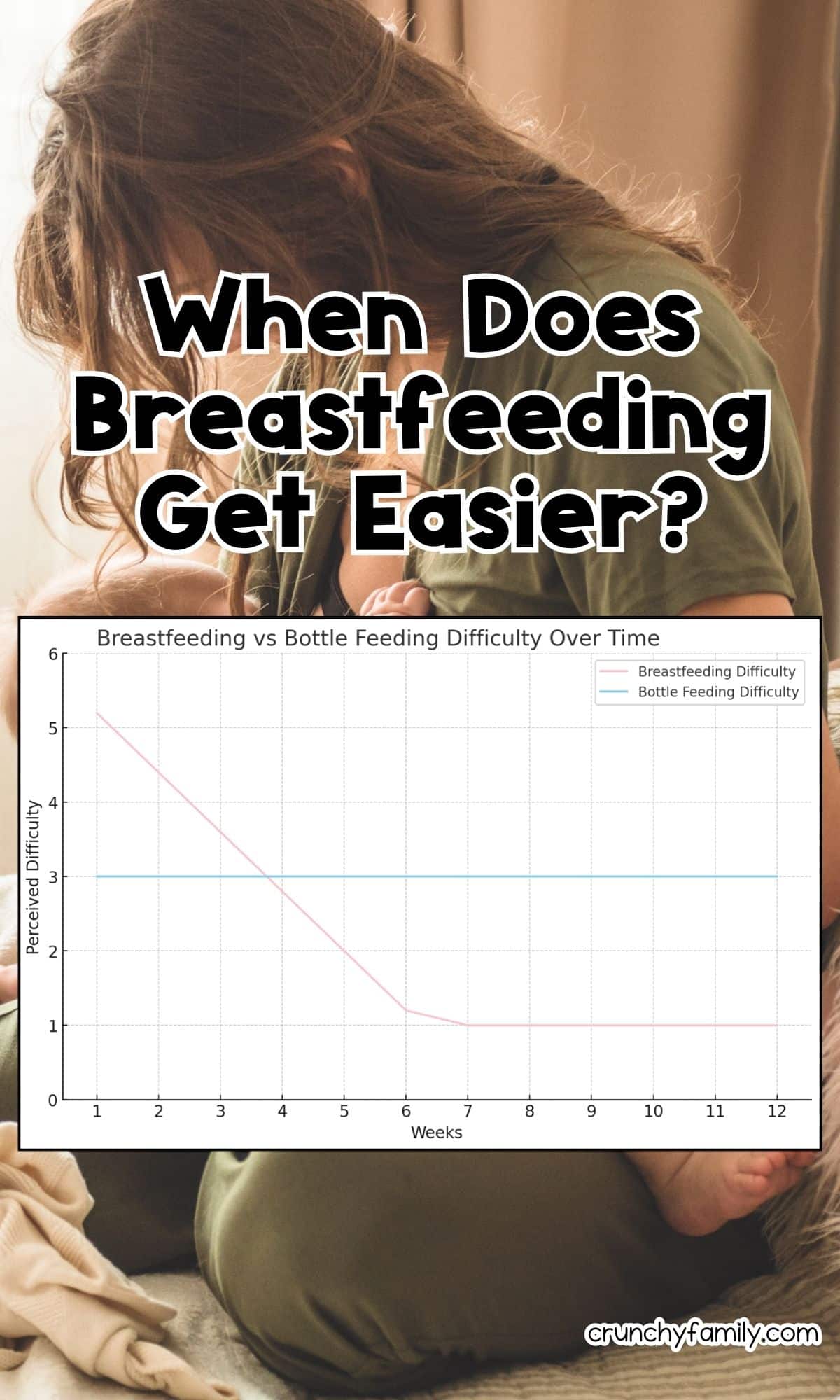If you’ve clicked on this article, chances are you’re somewhere at the beginning of your breastfeeding journey, perhaps feeling a bit like you’re climbing a mountain with no peak in sight.
I’m here to share not only some personal stories and encouragement but also to talk about a common question many new moms find themselves asking: when does breastfeeding get easier?

Breastfeeding is a natural process, but that doesn’t mean it comes naturally to all of us. In the early days, everything is a learning process for both you and your baby. Finding that good latch might take time, and yes, despite what the books say, sometimes it hurts.
This can be due to a range of issues, from needing to adjust your breastfeeding position to dealing with sore nipples or even a tongue tie.
If you’re experiencing pain or any other breastfeeding difficulties, reaching out to a lactation consultant can be a game-changer. Getting support from fellow moms, and other female relatives who’ve been through the newborn period themselves can also be a huge help.
Remember, it’s not supposed to be a solo journey; support groups, healthcare providers, your health visitor or a public health nurse can offer invaluable advice and emotional support whilst you get to grips with breastfeeding.

When Does Breastfeeding Get Easier Diagram
We’ve sketched out a simple visual representation showing the relative ease and difficulty of breastfeeding versus bottle feeding over the initial weeks.
The key takeaway is that while breastfeeding might start as a challenge, peaking in difficulty within the early weeks, it generally becomes significantly easier, especially when compared to the constant level of effort required for bottle feeding.
But note that this graph reflects our views based on personal and shared experiences; every mom’s journey is unique.

My own breastfeeding journey reflects the diversity of experiences one can have. With my first son, the early weeks were overwhelming. Despite my best efforts, I struggled to produce enough milk, and to get him latched correctly, leading to a fussy baby and a very stressed mom.
Eventually, I decided to switch to formula, and the relief was immediate. I had put immense pressure on myself to exclusively breastfeed, but in the end, what mattered to me at that point was that my baby was fed and happy.
As time went on and I welcomed more children, I noticed a surprising trend: each breastfeeding experience was easier than the last. By baby number three, I was a pro, taking to breastfeeding with much less stress and far more confidence.
I learned the importance of early skin contact, the signs of a good milk supply (hello, wet diapers and weight gain!), and how to breastfeed comfortably on the go.

Breastfeeding isn’t just about feeding; it’s a bonding experience, a period of growth and learning for both you and your child.
Yes, even though it’s the most natural thing in the world, the first couple of weeks can still be tough. You’re dealing with recovering from baby’s birth, sleep deprivation, possible milk production issues, and the adjustment to a new baby’s feeding pattern.
But once you get over that initial hump, the benefits are immeasurable.
There’s no need to prep bottles or worry about bringing supplies when you’re out and about. Plus, breastfeeding for longer periods can reduce your baby’s risk of illnesses and even decrease the likelihood of developing conditions like breast cancer for moms.
The First Few Weeks and Months
During these initial weeks of breastfeeding, you might have noticed your baby’s feeding pattern adjust during growth spurts and cluster feeding periods. These are natural phases where your baby may seem insatiable, often seeking the breast more frequently.
Such stages are crucial for increasing your breast milk supply to meet the burgeoning needs of your breastfed baby.

For new mums navigating the first baby’s feeding needs, the amount of milk and ensuring there’s enough breast milk can feel overwhelming. It’s essential to remember that every baby’s needs are unique, and so is your milk production. If you’re worried about your supply, check out our post on boosting milk supply, but as long as your baby is gaining weight and having plenty of wet diapers, it’s likely your supply is absolutely fine with enough breastmilk. Not everyone leaks milk, or is able to get much milk when they try to express milk, and that’s doesn’t have to indicate any problem.
The first day, the first week, and even the first month are all about learning – for both you and your baby. Whether it’s finding a comfortable breastfeeding position, understanding the signs of a good latch, or navigating the use of tools like nipple shields, it’s all part of the journey.
If you’re experiencing pain in the early days of breastfeeding, it’s not uncommon, and there are several supportive measures you can try.
A nipple shield can be particularly helpful for sore nipples, offering a protective barrier while nursing. Additionally, applying lanolin cream after feedings can soothe and help heal the skin, providing relief from discomfort. Both of these methods can make a significant difference, allowing you to continue breastfeeding more comfortably.
If concerns about milk supply or baby’s weight gain persist, reaching out to a healthcare provider or a lactation consultant is a good idea. They can offer support, identify possible causes for common problems, and reassure you about the normalcy of your experience.

Exclusive breastfeeding is recommended by the World Health Organization for the first six months of life, but it’s not without its challenges. From sore nipples to concerns about milk supply, the early weeks can be a test of resilience, but it’s for a comparatively short time and yes it really can get easier.
In the first couple of months, you may feel like breastfeeding is a round-the-clock job. But as you introduce solid foods and continue to nurture your baby, you’ll find a rhythm that works for both of you. Breastfeeding might start as hard work, but it transforms into an easy, natural way to care for your baby. Every new mum’s journey is unique, filled with its own set of challenges and triumphs. Yet, one thing remains constant: the incredible bond it fosters between you and your baby.
After 6 Months: Introducing Solid Foods
A significant milestone in your breastfeeding journey comes around the six-month mark when you can start introducing solid foods to your baby. This transition is not only a major milestone in your baby’s growth but also signifies a shift in their nutritional needs.

Until this point, your baby has relied entirely on breast milk or formula to meet their dietary requirements. The introduction of solid foods gradually reduces the sole dependency on breast milk, offering a bit of relief to new mums. So, if you’re a couple of months in and still finding it hard going – perhaps the 6 month mark will be a time that you find breastfeeding gets easier. Perhaps with slightly less frequent feeds, as the amount of solid food your baby takes to increases… for some mothers this does make it feel easier, as your breastfed babies are now not purely 100% reliant on you for nutrition any more.
The introduction of solid foods at around six months of age not only diversifies your baby’s diet but also can ease the pressure on you to be the sole source of nutrition. This doesn’t mean breastfeeding ends; breast milk remains a vital source of nourishment and immunity for your baby. Yet, the frequency of feeds may lessen, and you’ll likely find that expressing milk or direct breastfeeding takes less time out of your day.
This period also brings about a deeper breastfeeding relationship between you and your baby. As they begin to explore new tastes and textures, you’ll continue to provide the comfort and nutrition of breast milk. Plus, with solid foods, your baby might start to experience longer periods of sleep – a welcome change for any new mother dealing with months of sleep deprivation.
But let’s not forget that every breastfeeding journey is different. What works for one family might not work for another, and that’s okay. Whether you’re a new mom struggling with low milk supply or a seasoned parent finding breastfeeding a breeze this time around, remember: it’s all about what’s best for you and your baby. The early days are hard, but they’re also filled with moments of profound joy and connection.
If you’re finding breastfeeding challenging right now, hold on. The hard work you’re putting in is not just about feeding your baby but about laying the foundation for a healthy, happy future for both of you. And remember, there’s no shame in seeking help, whether it’s from family members, a breastfeeding class, or even just a deep breath and a dab of nipple cream.
Your breastfeeding journey is yours alone, and no matter how it unfolds, know that you’re doing an incredible job in the care of your baby.

8 thoughts on “When Does Breastfeeding Get Easier?”